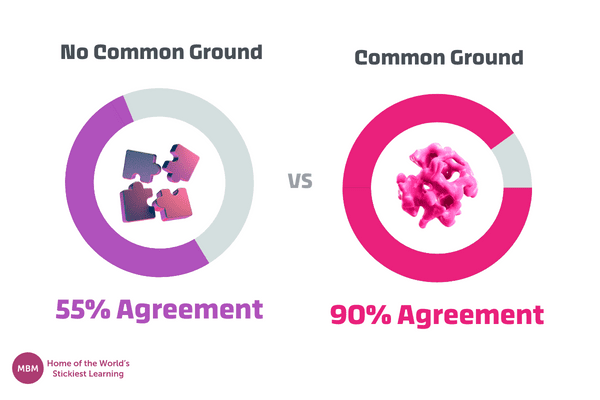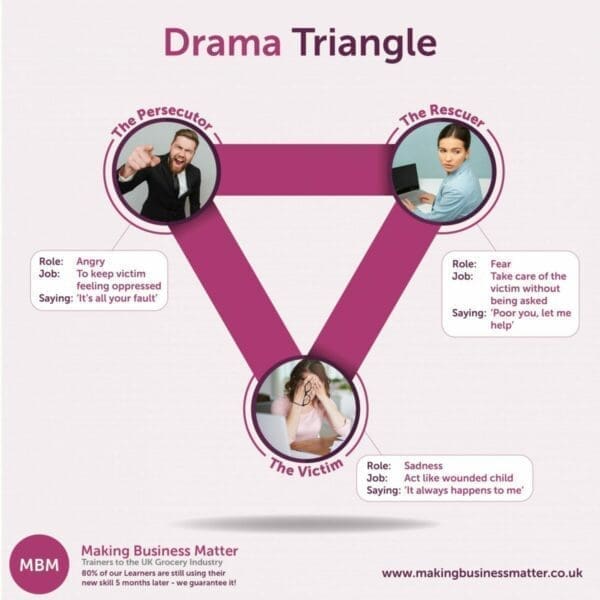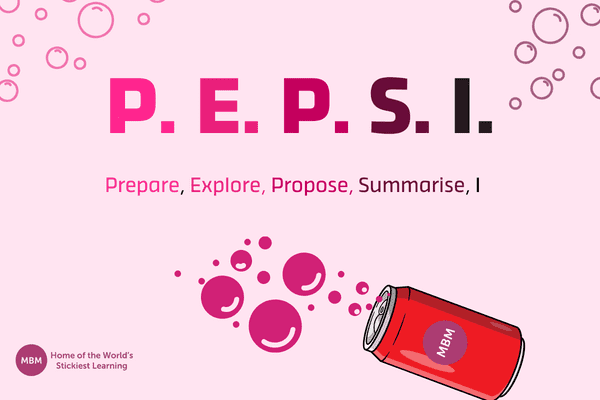In 30 years of Negotiating, I have seen the Tough, the Hard and the Fist Bangers – It does not mean they are Great Negotiators.
When most people think of great negotiators they think of the big, the bad and the ugly. Lord Sug, and alike come to mind. Those who intimidate. Let me ask you a question…
Who was the best boss you worked for? That person is the one you ran through walls for.
And who was your worst boss? You didn’t run through walls for that person. In fact, you didn’t do the minimum either – you couldn’t – but you also didn’t take risks for that person, try anything new or go the extra mile for fear of being told off.
Negotiating is similar. If someone intimidates you in a negotiation, yes, they may get the best deal, but behind the scenes and in the next deal, you do all that you can to ‘get them back.’
This does not mean for a second we roll over. Absolutely not. I am simply saying that there is a third way; not banging our fists on the table, and also not rolling over & having our tummy tickled. Assertive and cooperative.
Separating the Types of Negotiations
You might approach a one-off negotiation, like buying a second-hand car, differently than an ongoing relationship with a customer. I accept this. When you negotiate with a car dealer, it’s a one-off and you’ll probably never see them again, so you might be different. A little more aloof, challenging, and more willing to walk away. But with a long-term customer, you cannot be. You need to find a way forward that works for you and them.
For this article, we are talking about long-term relationship negotiations, where you want to win over time.
The Big, The Bad and The Ugly
These guys might win sometimes, but here’s their secret. It’s that they don’t win that often. They win the war on macho, ego, and toughness, but they don’t get the best deal. Here’s why…
Robert Cialdini, the author of the 7 principles of persuasion, tells us about ‘Liking’ in the fifth principle. He speaks of a piece of research about a series of negotiation studies carried out between MBA students at two business schools. Some of the student groups were told:
Time is money. Get straight down to business.’
In this group, around 55% were able to come to an agreement.
And in a second student, they were told:
Before you begin negotiating, share some personal information with each other. Identify a similarity you share in common then begin negotiating.’
In this group, 90% were able to come to successful and agreeable outcomes that were typically worth 18% more to both parties.

So, the conclusion of this research is that when common ground is found the ability to reach an agreement rose by +35ppts. Plus, both parties won about 20% more. This also bears out in real life because we know that we are more collaborative with people we like and trust.

The big bad guys do not understand intimacy. It is one of the 4 parts of the trust equation. The other parts of the trust equation are Credibility, Reliability and Self Orientation.
Intimacy is about how much I know about you and how much you know about me. It could just be that we know that I have kids and you have kids. A common topic. This can be enough to form a foundation of trust, and we all know that when you trust someone you are more likely to collaborate with them.
Moving House is a Great Common Ground
Recently I moved house and I have found it to be a great common ground because everyone has moved and everyone found it to be a stressful event. The reason I believe this topic works is that everyone has moved and they all found it to be stressful. But not only this, it’s because of the drama triangle effect.

In essence, the drama triangle states that there are 3 parties; the attacker, the victim and the rescuer. This triangle is the basis of all stories and films. In the case of moving house, we come together as victims attacked by a system that is flawed and then we both move to rescuer because we both got through it.
Again, following the path of building trust and liking someone does not mean that we are soft and that you will accept a bad deal. In fact, the opposite is true. You are building a connection with someone in order to win more together.
On The Flip Side…
Looking at this the other way, distrust will mean that both parties are not going to disclose useful information, be aloof and that the negotiation will probably take longer and be much more protracted.
As one supplier once told me, when I was a buyer, ‘My only want, Darren, is not to be fired on a phone call.’ He knew that if he built a relationship with me then I was more likely to tell him face-to-face that he was fired. This was because I trusted him, maybe even liked him, and if I did want to tell him he was fired I’d do it in a face-to-face meeting which he knew would give him every opportunity to share why he should stay and save his job (his business). Put another way, you will be kinder to your friends.
The More Effective Approach of Great Negotiators
Learn the art of negotiating. Don’t learn the macho, learn the way that great negotiators negotiate. Not with their fists or through intimidation but with a great approach to achieving a win for themselves and secondly for the other party.

There are 5 pieces of the art of negotiating that you need to know in order to be a great negotiator. They are:
#1: Learn How to Prepare and It Does Not Begin With Powerpoint
When getting ready for a negotiation most people open Powerpoint & create slides. This process is wrong because the thinking you are being asked to do is through the medium of slides. Slides are used to present, not for structuring your approach to negotiation. It’s like not being able to find a screwdriver to screw in a screw, so you reach for a hammer. We need a tool that encourages us to think about the negotiation from several different angles, which will help us to be more prepared. With preparation comes confidence and with confidence comes better outcomes. Introducing the squaredance tool…
A simple one-page template designed to help you to consider the key 5 parts of the negotiation; wish, walk-away, gives, takes, and tactics. By completing this simple template you will have prepared what you want, what you are prepared not to give, what you will give, what you will take, and the tactics you will employ to get more of what you want and to give away less.
In this article, you can download the template for free, discover how to use it and explore the more advanced stages of how to prepare for a negotiation effectively.
#2: Know the 4 Stages of Negotiation
When most people negotiate, they get stuck in and then find themselves at a stalemate. This is because they have skipped the first two stages of the negotiation, and it happens for one of 3 reasons:
- They were nervous, lacked confidence and just wanted to get into it quickly so that it might be over quickly.
- Not aware that a negotiation had stages, let alone 4.
- Aware of the first two stages but ‘they didn’t have the time’ – a poor excuse because they didn’t see the value, and now they are in a deadlock and spending twice as much effort to break it.
The 4 stages of negotiation are; Prepare, Explore, Propose, and Summarise. The mnemonic for this is:

(Obviously the ‘I’ is missing, though it is the final stage.)
The fifth stage is you privately considering, ‘What did I get?’
For most people, they start at the third stage – the proposal stage, and then have their proposal rejected, then argue, and then find that they have no way through. That is why so many negotiations are escalated.
To avoid this, begin with stage 1 – Preparation, by preparing, which is where the squaredance tool comes in very handy.
You can find out much more about the stage of negotiation in this article called, ‘Process of negotiation.’
#3: Stage Two is About Exploring and This is Key to Your Success
Stage 2 is about exploring, which is all about asking open questions to discover what the other party wants.
For example, let’s say you go to a car dealer’s forecourt and you find yourself drooling over the red 2-seater sports car. The salesperson comes over and starts with their patter, ‘Only one owner, full-service history, and I’m sure I can do something on the price…’ She goes on.
If only they had not started at stage 3 and instead started at stage 2, they might have discovered that you have 4 kids and really need an SUV, as the sportscar is only a dream. No matter how hard the salesperson sells & negotiates they’ll never sell that sportscar to you.
Asking does not mean you agree. You may ask; What cost are you looking for? Why that specific cost? When do you need it by? What is important to you? How did the last supplier let you down? What does great look like? …The list is endless. Getting the information does not mean that you have said yes to any of it. You are just finding out.
You just need to use an open question, ask and shut up & listen to the answers. Imagine you’re that salesperson, what questions would you ask to know what type of car the customer wants? Once you know, you can then move to stage 3 and build a proposal that meets as many of their expectations as you can.
Ask, and it will be given to you; seek, and you will find; knock, and it will be opened to you.’ – Matthew 7:7 of The Bible.
#4: Role Play – I Know You Hate It!
The problem is that it works. You know it does and so do I, yet so many negotiators go into battle for millions of pounds and are surprised by the blind alleys they find themselves in when an internal role play would have helped them identify what they were.
Roleplay, acting, not real life – I hear you – Unfortunately, it works, so don’t role-play, BE YOURSELF. If a colleague can help you discover something you might not see, or that you hadn’t thought about X or that Y was always going to be the place you get to, and you need a way out, do it. Do it more.
We have a saying here at MBM:

It doesn’t need to be awkward or difficult because you’ve probably already told a colleague all about ‘Bob the Buyer’ anyway. It is now just practising by negotiating with ‘colleague Bob’ for 10/20 minutes and seeing what happens. Moreover, it might be a little awkward and your colleague might win the negotiation. But it’s better that they win in practice than actually Bob wins millions in battle.
#5: You Haggle and Don’t Negotiate
It’s tough but true. Most of the time you are haggling. At the bazaar, you are asking about the price of the Roy Bans (Not a spelling mistake!) and they start at 24, and you start and 12 and you meet in the middle. This is a valid form of resolving a conflict. They are 8 possible ways to solve a conflict. Haggling and negotiation are two and they are not the same.
Haggling is about a single dimension, usually price, and you each start high and meet in the middle. Negotiating is more complex, more of an art form and involves stages, levels, and many items, and involves understanding body language, how to close, and other such wonderful things.
Understand the difference between haggling and negotiating in this article.
Concluding How to Be a Great Negotiator
Don’t be fooled by the films, tv, and urban myths of great negotiators that are tough, mean and threatening. There is another way and it is a better way. It requires emotional intelligence, a deep understanding of how people can work together, and a sharp curiosity. Be a great negotiator, be you. Just be a you that understands the fundamentals of negotiating and that there is more than one way to negotiate.
Be the best version of you and go get ’em!’ – Darren A. Smith
Action: For even more useful content on negotiations, check out our ultimate guide on negotiation skills.




